第19章 Redis的一些常用技术
19.1 Redis的基础事务
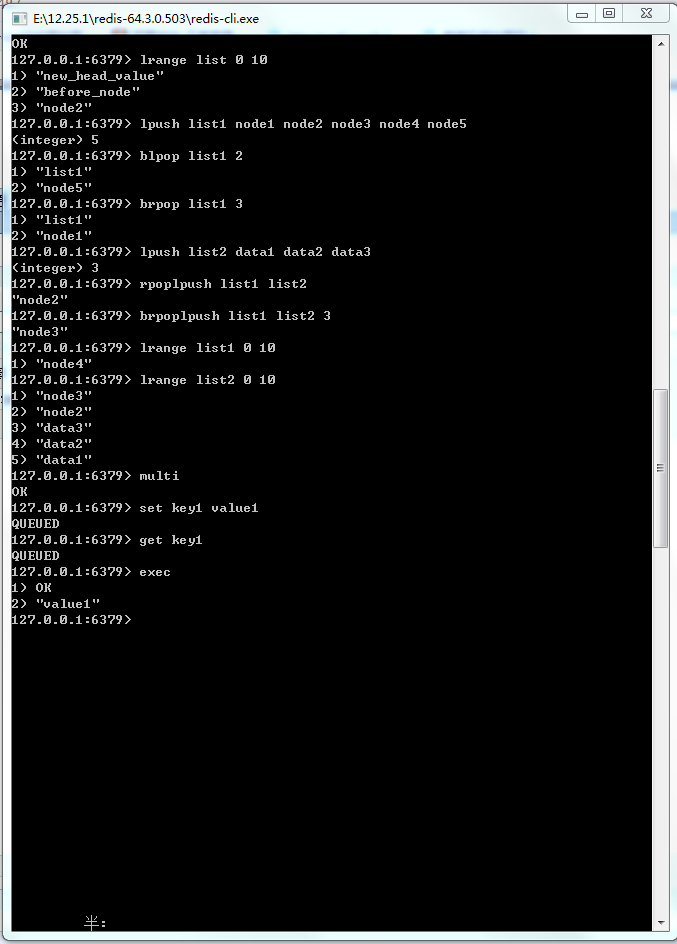
图19-1 Redis命令执行事务的过程
19-1:在Spring中使用Redis事务命令
public static void testTransaction(){ ApplicationContext applicationContext = new ClassPathXmlApplicationContext("applicationContext.xml"); RedisTemplate redisTemplate = applicationContext.getBean(RedisTemplate.class); SessionCallback callBack = (SessionCallback)(RedisOperations ops) -> { ops.multi(); ops.boundValueOps("key1").set("value1"); // 注意由于命令只是进入队列,而没有被执行,所以此处采用get命令,而value却返回为null String value = (String) ops.boundValueOps("key1").get(); System.out.println("事务执行过程中,命令入队列,而没有被执行,所以value为空:value=" + value); // 此时list会保存之前进入队列的所有命令的结果 ops.exec();// 执行事务 // 事务结束后,获取value1 value = (String) redisTemplate.opsForValue().get("key1"); return value; }; // 执行Redis的命令 String value = (String) redisTemplate.execute(callBack); System.out.println(value); }
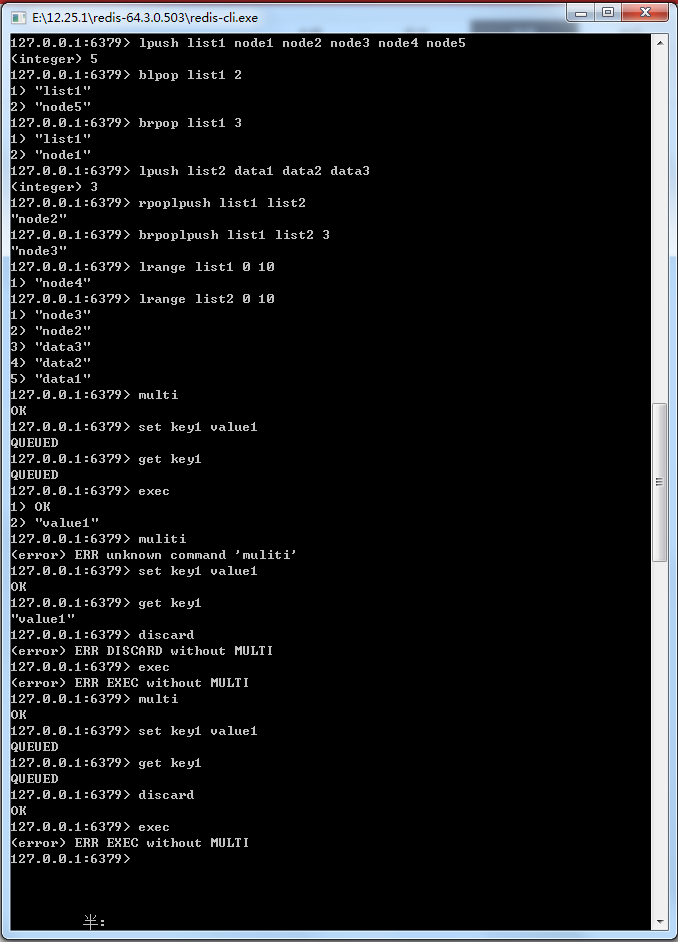
图19-2 使用discard命令取消事务
19.2 探索Redis事务回滚
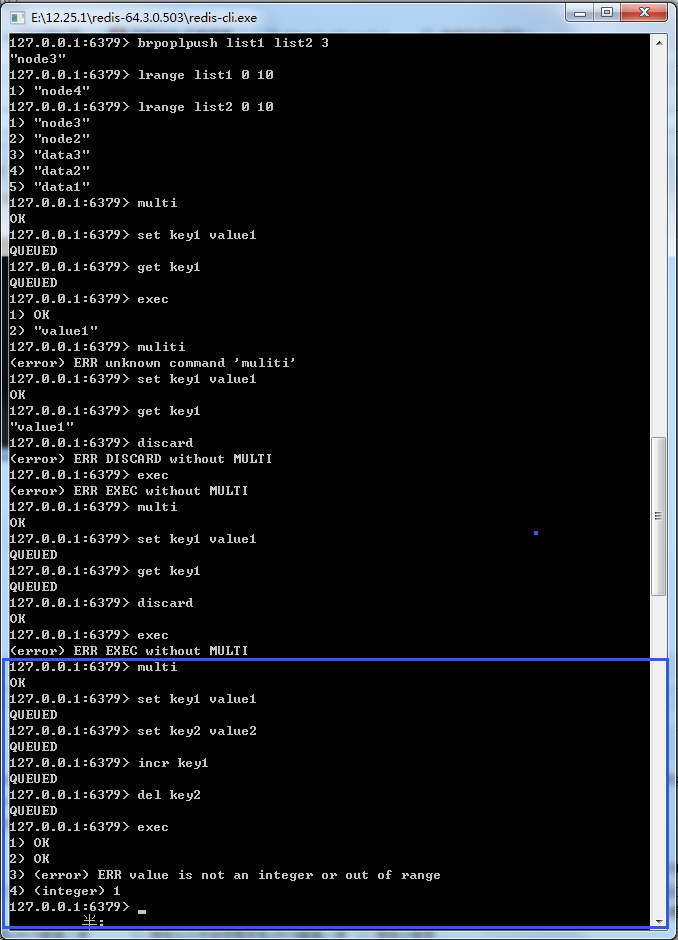
图19-3 Redis事务遇到命令格式正确而数据类型不符合

图19-4 Redis事务遇到命令格式错误的
19.3 使用watch命令监控事务
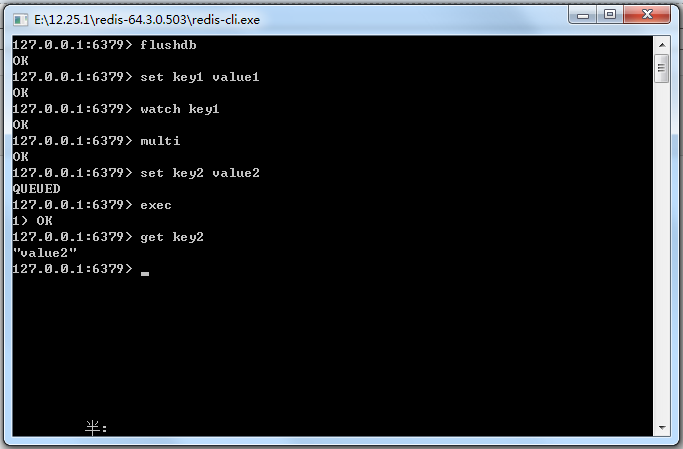
图19-6 Redis执行事务


图19-7 测试Redis事务回滚
19.4 流水线(pipelined)
19-2:使用流水线操作Redis命令
public static void testJedisPipeline() { JedisPool pool = getPool(); Jedis jedis = pool.getResource(); long start = System.currentTimeMillis(); // 开启流水线 Pipeline pipeline = jedis.pipelined(); // 这里测试10万条的读/写2个操作 for (int i = 0; i < 100000 ; i++) { int j = i + 1; pipeline.set("pipeline_key_" + j, "pipeline_value_" + j); pipeline.get("pipeline_key_" + j); } // pipeline.sync();//这里只执行同步,但是不返回结果 // pipeline.syncAndReturnAll();将返回执行过的命令返回的List列表结果 List result = pipeline.syncAndReturnAll(); long end = System.currentTimeMillis(); // 计算耗时 System.err.println("耗时:" + (end - start) + "毫秒"); }
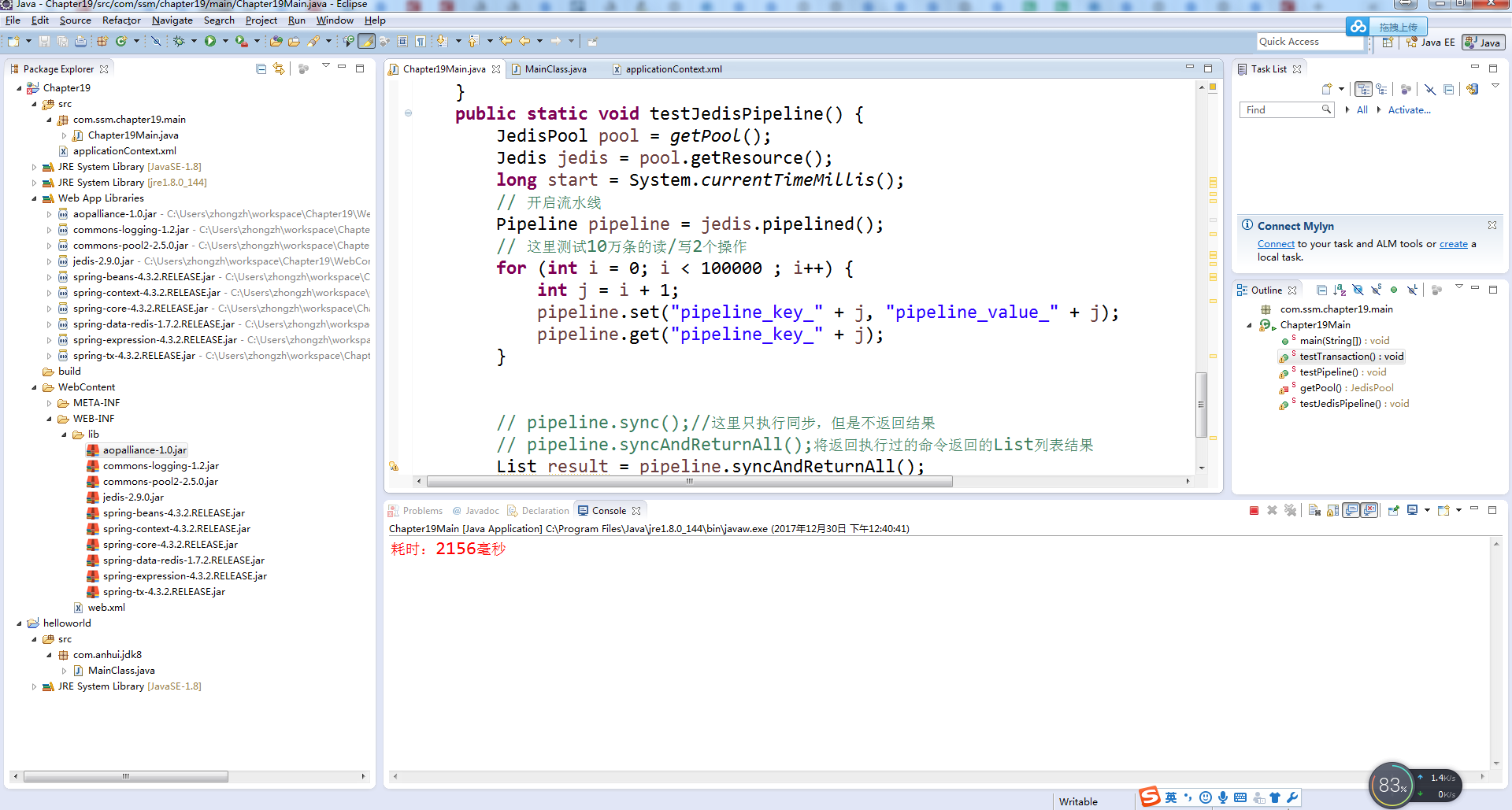
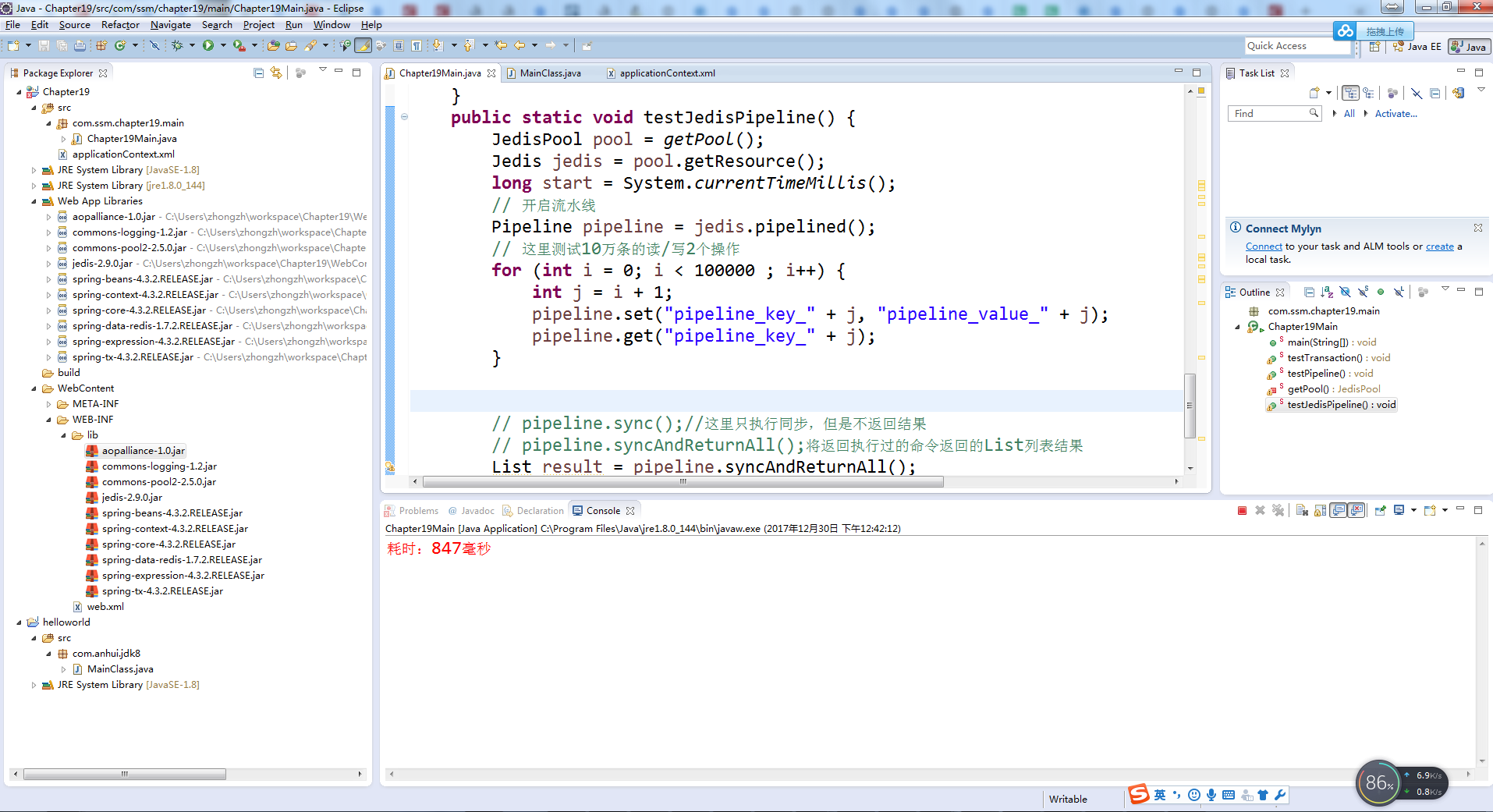
19-3:使用Spring操作Redis流水线
public static void testPipeline(){ ApplicationContext applicationContext = new ClassPathXmlApplicationContext("applicationContext.xml"); RedisTemplate redisTemplate = applicationContext.getBean(RedisTemplate.class); // 使用Java8的Lambda表达式 SessionCallback callBack = (SessionCallback) (RedisOperations ops) -> { for(int i = 0; i < 100000; i++){ int j = i + 1; ops.boundValueOps("pipeline_key_" + j).set("pipeline_value_" + j); ops.boundValueOps("pipeline_key_" + j).get(); } return null; }; long start = System.currentTimeMillis(); // 执行Redis的流水线命令 List resultList = redisTemplate.executePipelined(callBack); long end = System.currentTimeMillis(); System.err.println(end-start); }
19-5 发布订阅



图19-10 Redis的发布订阅过程
代码清单19-4:Redis发布订阅监听类
package com.ssm.chapter19.redis.listener; import org.springframework.data.redis.connection.Message; import org.springframework.data.redis.connection.MessageListener; import org.springframework.data.redis.core.RedisTemplate; import org.springframework.data.redis.serializer.SerializationException; /*** imports ***/ public class RedisMessageListener implements MessageListener{ private RedisTemplate redisTemplate; /*** 此处省略redisTemplate的setter和getter方法 ***/ @Override public void onMessage(Message message, byte[] bytes) { // TODO Auto-generated method stub // 获取消息 byte[] body = message.getBody(); // 使用值序列化器转换 String msgBody; String channelStr = null; try { msgBody = (String) getRedisTemplate().getValueSerializer().deserialize(body); System.err.println(msgBody); // 获取channel byte[] channel = message.getChannel(); // 使用字符串序列化器转换 channelStr = (String) getRedisTemplate().getStringSerializer().deserialize(channel); } catch (SerializationException e) { // TODO Auto-generated catch block e.printStackTrace(); } System.err.println(channelStr); // 渠道名称转换 String bytesStr = new String(bytes); System.err.println(bytesStr); } public RedisTemplate getRedisTemplate() { return redisTemplate; } public void setRedisTemplate(RedisTemplate redisTemplate) { this.redisTemplate = redisTemplate; } }
<?xml version='1.0' encoding='UTF-8' ?> <!-- was: <?xml version="1.0" encoding="UTF-8"?> --> <beans xmlns="http://www.springframework.org/schema/beans" xmlns:xsi="http://www.w3.org/2001/XMLSchema-instance" xmlns:p="http://www.springframework.org/schema/p" xmlns:aop="http://www.springframework.org/schema/aop" xmlns:tx="http://www.springframework.org/schema/tx" xmlns:context="http://www.springframework.org/schema/context" xsi:schemaLocation="http://www.springframework.org/schema/beans http://www.springframework.org/schema/beans/spring-beans-4.0.xsd http://www.springframework.org/schema/aop http://www.springframework.org/schema/aop/spring-aop-4.0.xsd http://www.springframework.org/schema/tx http://www.springframework.org/schema/tx/spring-tx-4.0.xsd http://www.springframework.org/schema/context http://www.springframework.org/schema/context/spring-context-4.0.xsd"> <bean id="poolConfig" class="redis.clients.jedis.JedisPoolConfig"> <property name="maxIdle" value="50" /> <property name="maxTotal" value="100" /> <property name="maxWaitMillis" value="20000" /> </bean> <bean id="stringRedisSerializer" class="org.springframework.data.redis.serializer.StringRedisSerializer" /> <bean id="connectionFactory" class="org.springframework.data.redis.connection.jedis.JedisConnectionFactory"> <property name="hostName" value="localhost" /> <property name="port" value="6379" /> <property name="poolConfig" ref="poolConfig" /> </bean> <bean id="redisTemplate" class="org.springframework.data.redis.core.RedisTemplate"> <property name="connectionFactory" ref="connectionFactory" /> <property name="defaultSerializer" ref="stringRedisSerializer" /> <property name="keySerializer" ref="stringRedisSerializer" /> <property name="valueSerializer" ref="stringRedisSerializer" /> </bean> <bean id="redisMsgListener" class="com.ssm.chapter19.redis.listener.RedisMessageListener"> <property name="redisTemplate" ref="redisTemplate" /> </bean> <bean id="topicContainer" class="org.springframework.data.redis.listener.RedisMessageListenerContainer" destroy-method="destroy"> <!--Redis连接工厂 --> <property name="connectionFactory" ref="connectionFactory" /> <!--连接池,这里只要线程池生存,才能继续监听 --> <property name="taskExecutor"> <bean class="org.springframework.scheduling.concurrent.ThreadPoolTaskScheduler"> <property name="poolSize" value="2" /> </bean> </property> <!--消息监听Map --> <property name="messageListeners"> <map> <!--配置监听者,key-ref和bean id定义一致 --> <entry key-ref="redisMsgListener"> <!--监听类 --> <bean class="org.springframework.data.redis.listener.ChannelTopic"> <constructor-arg value="chat" /> </bean> </entry> </map> </property> </bean> </beans>
代码清单19-5:测试Redis发布订阅
package com.ssm.chapter19.main; import org.springframework.context.ApplicationContext; import org.springframework.context.support.ClassPathXmlApplicationContext; import org.springframework.data.redis.core.RedisTemplate; public class Chapter19Main { public static void main(String[] args) { ApplicationContext applicationContext = new ClassPathXmlApplicationContext("applicationContext.xml"); RedisTemplate redisTemplate = applicationContext.getBean(RedisTemplate.class); String channel = "chat"; redisTemplate.convertAndSend(channel, "I am lazy!!"); } }
public static void testPubSub(){ ApplicationContext applicationContext = new ClassPathXmlApplicationContext("applicationContext.xml"); RedisTemplate redisTemplate = applicationContext.getBean(RedisTemplate.class); String channel = "chat"; redisTemplate.convertAndSend(channel, "I am lazy!!"); }
public static void main(String[] args) { /* ApplicationContext applicationContext = new ClassPathXmlApplicationContext("applicationContext.xml"); RedisTemplate redisTemplate = applicationContext.getBean(RedisTemplate.class); String channel = "chat"; redisTemplate.convertAndSend(channel, "I am lazy!!");*/ testPubSub(); }

19.6 超时命令

图19-11 Redis超时命令

代码清单19-6:使用Spring操作Redis超时命令
public static void testExpire() { ApplicationContext applicationContext = new ClassPathXmlApplicationContext("applicationContext.xml"); RedisTemplate redisTemplate = applicationContext.getBean(RedisTemplate.class); redisTemplate.execute((RedisOperations ops) -> { ops.boundValueOps("key1").set("value1"); String keyValue = (String) ops.boundValueOps("key1").get(); Long expSecond = ops.getExpire("key1"); System.err.println(expSecond); boolean b = false; b = ops.expire("key1", 120L, TimeUnit.SECONDS); b = ops.persist("key1"); Long l = 0L; l = ops.getExpire("key1"); Long now = System.currentTimeMillis(); Date date = new Date(); date.setTime(now + 120000); ops.expireAt("key", date); return null; }); }
public static void main(String[] args) { /* ApplicationContext applicationContext = new ClassPathXmlApplicationContext("applicationContext.xml"); RedisTemplate redisTemplate = applicationContext.getBean(RedisTemplate.class); String channel = "chat"; redisTemplate.convertAndSend(channel, "I am lazy!!");*/ //testPubSub(); testExpire(); }
19.7 使用Lua语言
19.7.1 执行输入Lua程序代码
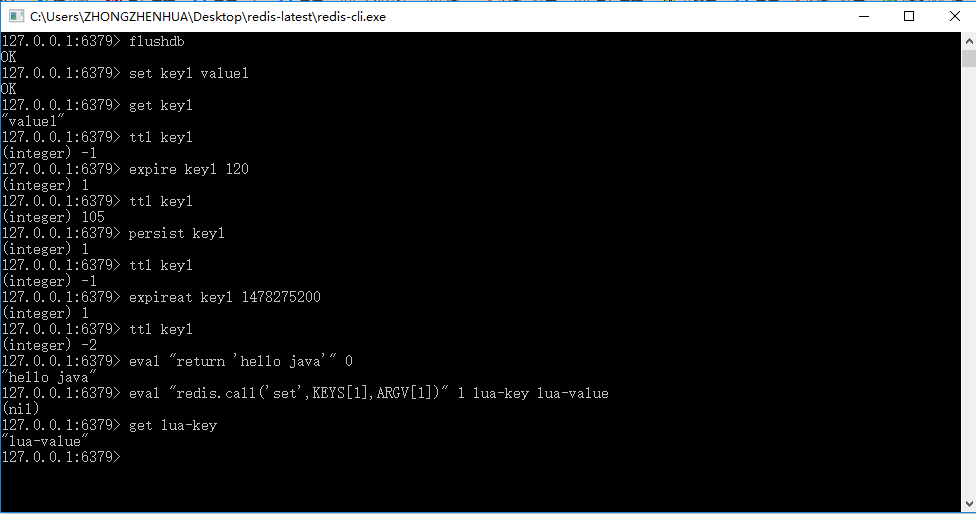
图19-12 Redis执行Lua语言脚本

图19-13 使用签名运行Lua脚本
代码清单19-7:在Java中使用Lua脚本
public static void testLuaScript(){ // 如果是简单的对象,使用原来的封装会简易些 ApplicationContext applicationContext = new ClassPathXmlApplicationContext("applicationContext.xml"); RedisTemplate redisTemplate = applicationContext.getBean(RedisTemplate.class); // 如果是简单的操作,使用原来的Jedis会简易些 Jedis jedis = (Jedis) redisTemplate.getConnectionFactory().getConnection().getNativeConnection(); // 执行简单的脚本 String helloJava = (String) jedis.eval("return 'hello java'"); System.out.println(helloJava); // 执行带参数的脚本 jedis.eval("redis.call('set',KEYS[1],ARGV[1])",1,"lua-key","lua-value"); String luaKey = (String) jedis.get("lua-key"); System.out.println(luaKey); // 缓存脚本,返回sha1签名标识 String sha1 = jedis.scriptLoad("redis.call('set',KEYS[1],ARGV[1])"); // 通过标识执行脚本 jedis.evalsha(sha1, 1, new String[]{ "sha-key", "sha-val"}); // 获取执行脚本后的数据 String shaVal = jedis.get("sha-key"); System.out.println(shaVal); // 关闭连接 jedis.close(); }
代码清单19-8:可序列化的Role对象
public class Role implements Serializable{ /** * */ private static final long serialVersionUID = 5334128099542779325L; private Long id; private String roleName; private String note; public Long getId() { return id; } public void setId(Long id) { this.id = id; } public String getRoleName() { return roleName; } public void setRoleName(String roleName) { this.roleName = roleName; } public String getNote() { return note; } public void setNote(String note) { this.note = note; } }
代码清单19-9:使用RedisScript接口对象通过Lua脚本操作对象
public static void testRedisScript() { ApplicationContext applicationContext = new ClassPathXmlApplicationContext("applicationContext.xml"); RedisTemplate redisTemplate = applicationContext.getBean(RedisTemplate.class); // 定义默认脚本封装类 DefaultRedisScript<Role> redisScript = new DefaultRedisScript<Role>(); // 设置脚本 redisScript.setScriptText("redis.call('set', KEYS[1], ARGV[1]) return redis.call('get', KEYS[1])"); // 定义操作的key列表 List<String> keyList = new ArrayList<String>(); keyList.add("role1"); // 需要序列化保存和读取的对象 Role role = new Role(); role.setId(1L); role.setRoleName("role_name_1"); role.setNote("note_1"); // 获得标识字符串 String sha1 = redisScript.getSha1(); System.out.println(sha1); // 设置返回结果类型,如果没有这句话,结果返回为空 redisScript.setResultType(Role.class); // 定义序列化器 JdkSerializationRedisSerializer serializer = new JdkSerializationRedisSerializer(); // 执行脚本 // 第一个是RedisScript接口对象,第二个是参数序列化器 // 第三个是结果序列化器,第四个是Redis的key列表,最后是参数列表 Role obj = (Role) redisTemplate.execute(redisScript, serializer, serializer, keyList, role); // 打印结果 System.out.println(obj); }
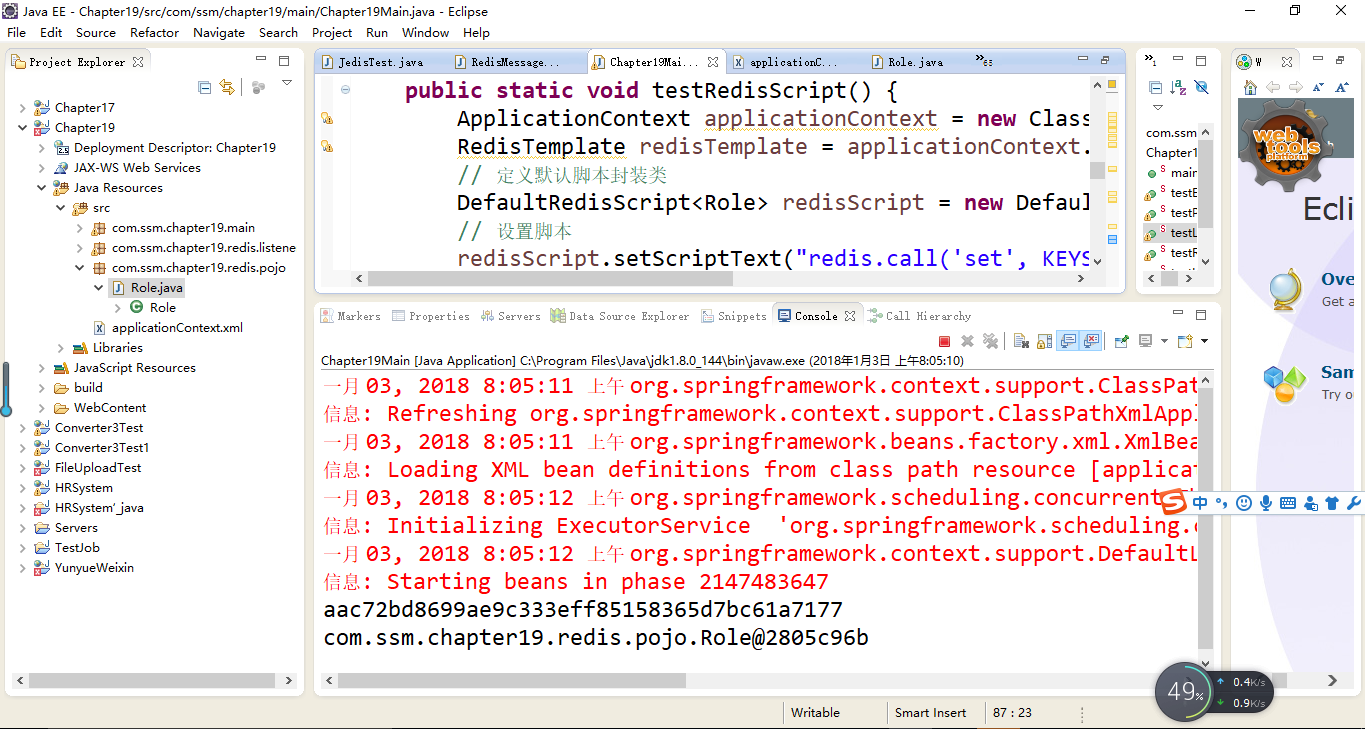
19.7.2 执行Lua文件
代码清单19-10:test.lua
redis.call('set', KEYS[1], ARGV[1]) redis.call('set', KEYS[2], ARGV[2]) local n1 = tonumber(redis.call('get' ,KEYS[1])) local n2 = tonumber(redis.call('get' ,KEYS[2])) if n1 > n2 then return 1 end if n1 == n2 then return 0 end if n1 < n2 then return 2 end

图19-14 redis-cli的命令执行
代码清单19-11:使用Java执行Redis脚本
public static void testLuaFile(){ ApplicationContext applicationContext = new ClassPathXmlApplicationContext("applicationContext.xml"); RedisTemplate redisTemplate = applicationContext.getBean(RedisTemplate.class); // 读入文件流 File file = new File("C:\\Users\\ZHONGZHENHUA\\Desktop\\redis-latest\\test.lua"); byte[] bytes = getFileToByte(file); Jedis jedis = (Jedis) redisTemplate.getConnectionFactory().getConnection().getNativeConnection(); // 发送文件二进制给Redis,这样Redis就会返回sha1标识 byte[] sha1 = jedis.scriptLoad(bytes); // 使用返回的标识执行,其中第二个参数2,表示使用2个键 // 而后面的字符串都转化为了二进制字节进行传输 Object obj = jedis.evalsha(sha1, 2, "key1".getBytes(),"key2".getBytes(),"2".getBytes(),"4".getBytes()); System.out.println(obj); } /** * 把文件转化为二进制数组 * * @param file * 文件 * @return 二进制数组 * */ public static byte[] getFileToByte(File file) { byte[] by = new byte[(int) file.length()]; try { InputStream is = new FileInputStream(file); ByteArrayOutputStream bytestream = new ByteArrayOutputStream(); byte[] bb = new byte[2048]; int ch; ch = is.read(bb); while(ch != -1) { bytestream.write(bb, 0, ch); ch = is.read(bb); } by = bytestream.toByteArray(); } catch (FileNotFoundException e) { // TODO Auto-generated catch block e.printStackTrace(); } catch (IOException e) { // TODO Auto-generated catch block e.printStackTrace(); } return by; }


